Europe, British Isles, England, North Yorkshire, Studley Royal Park, Fountains Abbey [Map]
Fountains Abbey is in Studley Royal Park [Map].
On 12 Jul 1245 William Percy 6th Baron Percy Topcliffe (age 48) died at Alnwick, Northumberland [Map]. He was buried at Fountains Abbey [Map]. His son Henry Percy 7th Baron Percy Topcliffe succeeded 7th Baron Percy of Topcliffe.
On 21 Nov 1297 Roger Mowbray 1st Baron Mowbray (age 40) died. He was buried at Fountains Abbey [Map]. His son John Mowbray 2nd Baron Mowbray (age 11) succeeded 2nd Baron Mowbray.
In 1314 Henry Percy 9th and 1st Baron Percy (age 40) died. He was buried at Fountains Abbey [Map]. His son Henry Percy 10th and 2nd Baron Percy (age 12) succeeded 2nd Baron Percy of Alnwick, 10th Baron Percy of Topcliffe.
After 1316 Rohese Clare Baroness Mowbray (age 61) was buried at Fountains Abbey [Map].
On 23 Mar 1322 at York [Map] ...
Roger Clifford 2nd Baron Clifford (age 22) was hanged. His brother Robert Clifford 3rd Baron Clifford (age 16) succeeded 3rd Baron de Clifford.
John Mowbray 2nd Baron Mowbray (age 35) was hanged. He was buried at Fountains Abbey [Map]. His son John Mowbray 3rd Baron Mowbray (age 11) succeeded 3rd Baron Mowbray.
by 1400 Furness Abbey [Map] had become the second richest and most powerful Cistercian abbeys in England, behind Fountains Abbey [Map].
In 1526 Abbot William Thirsk was appointed Abbot of Fountains.
In Jul 1534 Thomas Wendy (age 34) was employed by Henry Percy 6th Earl of Northumberland (age 32) with an annuity of £3 6s.8d. from Fountains Abbey [Map], the grant being made at the instance of the earl, a benefactor of the abbey. Wendy was employed by Northumberland in a number of other capacities. In March 1535 he executed with the earl a deed transferring the Percy lands in Sussex to the crown. He carried a number of letters from the earl to Cromwell in 1536 and 1537 and attended him at Hackney in his last illness in June 1537.
Around 30 May 1537 the Abbots of Fountains Abbey [Map], Marmaduke Bradley, and Gisborough Priory [Map], Robert Pursglove, were hanged, drawn and quartered at Tyburn [Map] for their role in the Pilgrimage of Grace. Their heads were displayed on London Bridge [Map].
On 26 Nov 1539 Fountains Abbey [Map] was surrendered Abbot Marmaduke Bradley, the prior, and thirty brethren, all priests. On 28 Nov 1539 pensions were assigned to the abbot (£100), prior (£8) and monks (£5 to £6 13s. 4d.).
On 01 Oct 1540, after its dissolution, Fountains Abbey [Map] was sold to Richard Gresham (age 55) who sold the some of the stone to offset the cost of purchase.
In 1597 Fountains Abbey [Map] was bought by Sir Stephen Proctor who used some of the stone to build Fountains Hall.
Vesta Monumenta. Plates 1.9 - 1.12: Engravings of the Ruins of Fountains Abbey [Map]
Plates 1.9-1.12 of Vetusta Monumenta depict the ruins of the twelfth-century abbey church of Fountains, Yorkshire, with extant monastic structures. The images offer significant visual evidence of the site as it stood in 1722, recording subsequently lost fabric, including the late twelfth-century cloister arcades, the tracery of the main windows of the abbey, the presbytery arcades and high altar enclosure. Engravings by George Vertue (age 39) after Samuel Buck. Published by the Society of Antiquaries of London in 1723. 190 x 367 mm, 189 x 364 mm, 192 x 370 mm, and 194 x 371 mm. Current location: Fountains, Ripon, North Yorkshire, UK.
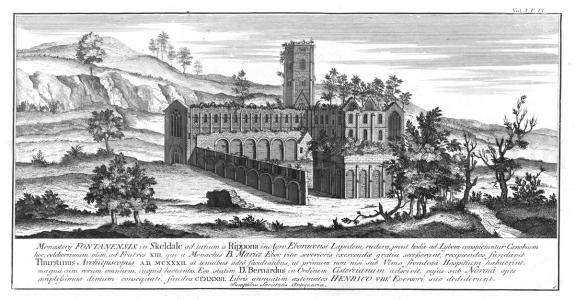
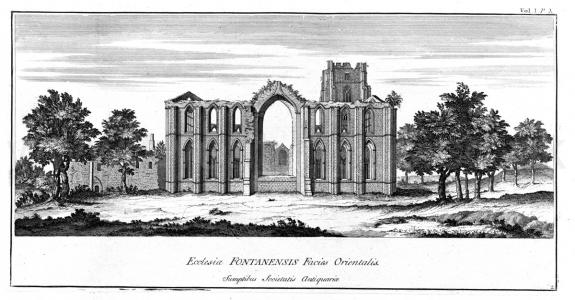
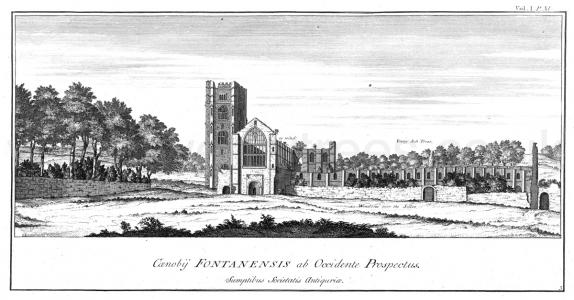
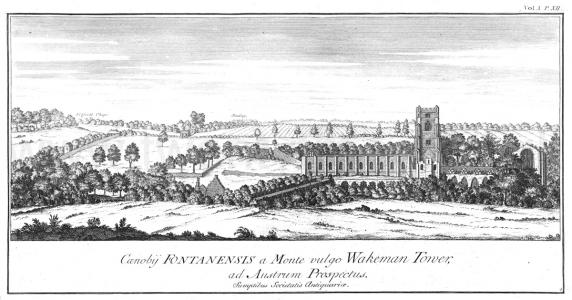
In Dec 1981 the video for the song Maid of Orleans (The Waltz Joan of Arc) by the band Orchestral Manoeuvres in the Dark was filmed at Brimham Rocks and Fountains Abbey [Map] (at 15 seconds, 1 minute 48 seconds and 2 minutes 46 seconds). Julia Tobin (age 26) played Joan of Arc.
.
Pershore Abbey [Map]. Early Medieval. Monument possibly to William de Harley. Left Leg Over Right. Sword in Left Hand. Holding a horn in his right hand. Fine band around his head. Head on single cushion.
Detailed description from Mark Downing of the Church Monuments Society posted to Facebook; abridged:
This limestone effigy lies flat on its back on a stone coffin, and is positioned in the middle of the south transept. The legs are missing below the knees. The figure is represented cross-legged (left over right). Below the head is a single rectangular cushion.
It wears a mail hauberk, mitten gauntlets and a coif all made in one. There is a cord around the head, above the face-opening, passing through rings of mail at wide intervals. A triangular flap which can be seen on the left side of the neck, represents the part of the mail coif called a ventail. This was a flap of mail drawn across the mouth to close the face-opening, and was secured to the temple either by a strap and buckle, or by a knotted cord. The mail of the armour is rendered by parallel rows of C's, alternate rows having the curves lying in the opposite directions. The rows of mail run around the coif, arms and hauberk. The left arm is partially concealed underneath the shield with the palm of the hand resting on top of the pommel of the sword. The right hand is bare, with the mitten-gauntlet off the hand, hanging loose around the wrist. The hand is holding a hunting horn at hip level, which has a strap passing through the lower-ring of a figure eight terminal. This strap is then attached around the horn at its rear and centre. Attached to the upper ring of the terminal is a loose strap which may have been used to suspend the horn from either the sword-belt or a baldric, the loose end falling underneath the hand.
Clearly shown within the opening of the gown, beneath the arm is an additional underlying body-defence. This almost certainly represents a coat of plates, joined together at the side by three straps with rectangular buckles, the straps emerging from within the upper-breast: the rivets would have been painted on. An effigy in the Temple church, London, is wearing a similar plate defence. The coat of plates consisted of a poncho-like garment with either a solid breast-plate sewn into it, or a series of metal plates attached by rivets to a textile cover. Visible at the neck, in the aperture of the coif, is a smooth garment. Presumably this represents the upper-chest portion of the coat of plates described above.
Worn over the coat of plates is a long sleeveless gown reaching to the calf, with the front open in the usual V-fashion. On the left arm, suspended from a guige which passes diagonally across the chest and over the right shoulder, is a long kite-shaped shield, which is concave towards the body. The shield is plain with no traces of heraldry present. Biting the tip of the shield is a damaged creature, possibly a griffin, dragon or wyvern.
The sword belt which has a square buckle is decorated with I-shaped bars, having a circular boss in their centres. The belt is attached to the scabbard by a single band. The loose portion of the belt falls to the thigh. The pommel of the sword is virtually concealed by the left hand. The grip is of medium length and the remains of the right quillon is worn. The sword, in its scabbard, lies at an angle on the left side of the figure, its tip broken.
Covering the knees and the lower part of the legs are mail hose. The mail represented in the same manner as on the coif and arms. Shown below the left knee is a strap, intended to stop the mail sagging down the leg.
Unfortunately the effigy has been damaged and has lost the lower part of the legs. A drawing by Thomas Dingley in the seventeenth century shows the effigy complete with an animal resting below the feet. The drawing also shows that originally stiff-leaf foliage was represented running along the right-hand edge of the slab, similar to that of William Longespèe ob.1227 (Wiltshire) Salisbury Cathedral [Map].
In 1838 the effigy was found buried on the north side of the church, with the stone coffin placed beneath it. Thomas Habington recorded the effigy on the north side of the quire, also with a hare at his feet which is now missing.
As previously mentioned a serpent or dragon is biting the point of the shield. The theory as to why these creatures are represented on monuments is not fully understood, but may derive from Psalm 91, v. 13. 'Thou shalt tread upon the lion and adder: the young lion and the dragon, shalt thou trample under foot'. These type of creatures are found on effigies in the North-East of England, for example at Egglesclffe, (Durham), Fountains Abbey [Map] c.1325 and Bainton c.1320-40, (both Yorkshire). It must be remarked that the Pershore effigy is not related to the examples found in the North-East as can be observed on stylistic grounds. Lawrence Stone remarks on a Westminster-Lincoln stylistic connection which may carry some weight, but as the effigy is so singular it is very difficult to attribute it to any single group. However the upper-drapery is not too dissimilar to work at Worcester Cathedral [Map] (q.v.), and Alfred C. Fryer has attributed both Worcester (1) and Pershore to the 'Bristol Workshop'.
A very unusual feature is the presence of a horn which is held in the right hand. Other effigies known to the writer where horns are represented can be seen for instance at: Glinton (Northamptonshire) c.1300-1325, Newland (Gloucestershire) c.1457, Skegby, (Nottinghamshire) c.1300 and Wadworth (Yorkshire), c.1300, all are dressed in civilian clothes whereas the Pershore effigy is represented in armour. The reason why the Pershore effigy is represented with a horn is open to at least two theories. The traditional belief is that he was a forest ranger or warden of the Kings forest. The second is that he held land by the horn, 'horngeld'. A splendid medieval oliphant horn known as 'The Savernake Horn' is preserved in the British Museum, London, which has silver enamelled mounts decorated with hunting dogs, forest animals, a seated King, a bishop and a forester. It is thought to have once belonged to the Sturmy family who were hereditary wardens of the Savernake forest from the early twelfth century until the first quarter of the fifteenth century and would add most weight to the theory of the Pershore effigy being a forest warden.
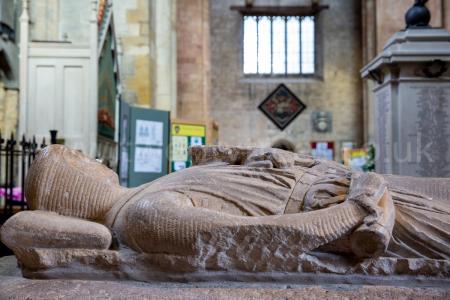
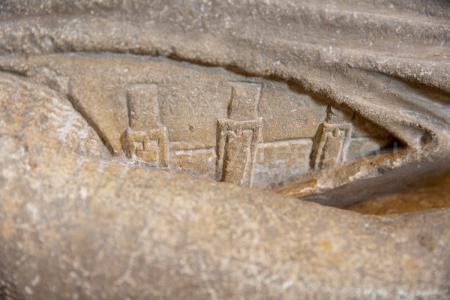
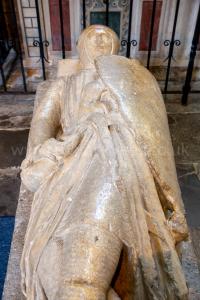
The River Skell rises around 3km north Pateley Bridge [Map] after which it travels broadly east past Fountains Abbey [Map], through Studley Royal Park [Map] and just south of Ripon [Map] before joining the River Ure 1.2 km east of Ripon [Map].